The ubiquitous guppy fish (Poecilia reticulata) was first identified in 1859.
Since then, it has become a favorite of both beginner and experienced aquarists alike.
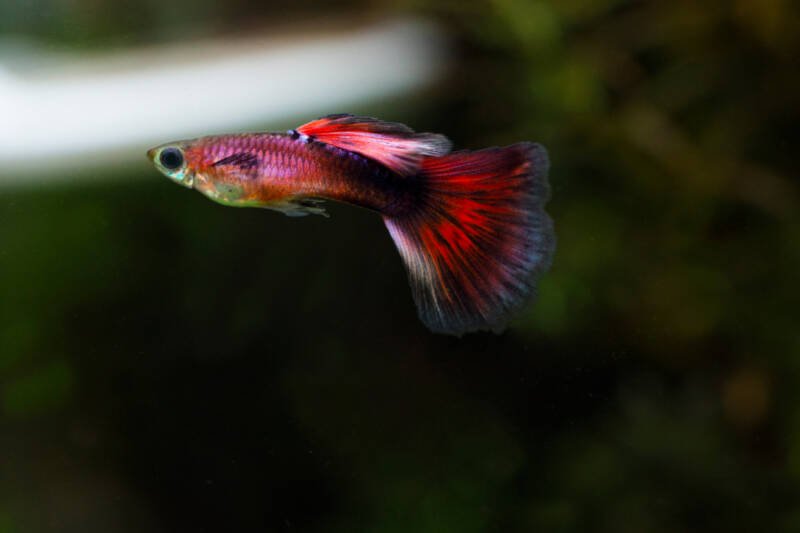
Caring for these fish is relatively simple; however, a key aspect to consider is their water quality.
Guppies are warm water, tropical fish. As such, knowing and maintaining the best water temperature for your guppy will provide them with the proper environment they need to live their healthiest life.
In this article
Guppy Natural Habitat
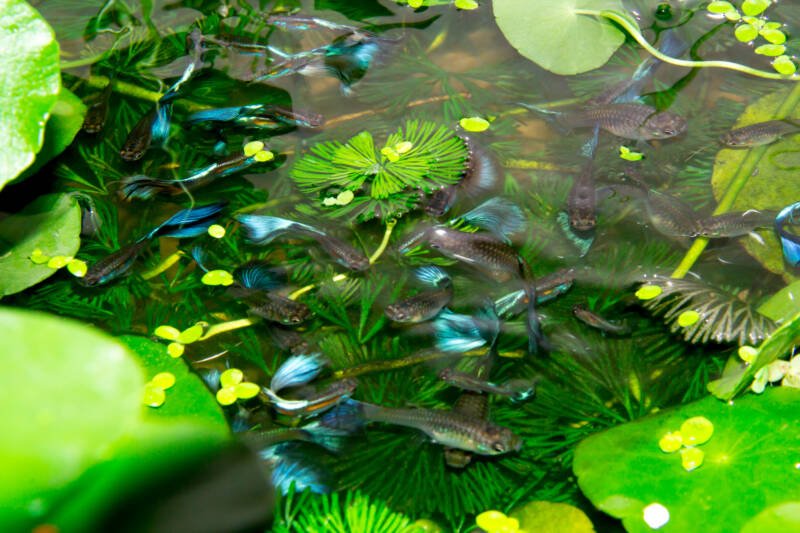
Guppies have an extensive natural range throughout the southern Lesser Antilles and northern South America. Large populations can be found in western Venezuela and Guyana.
Non-native populations of guppies are also found in numerous locations due to purposeful or accidental release.
In parts of California, guppies were released in efforts to control mosquito populations.
Non-native populations are widespread due to the guppy’s ability to outcompete local species for resources.
In fact, the guppy has been implicated in the decline of numerous native species.
The common thread throughout these various environments where guppies thrive is warm water.
What Water Temperature Do They Need
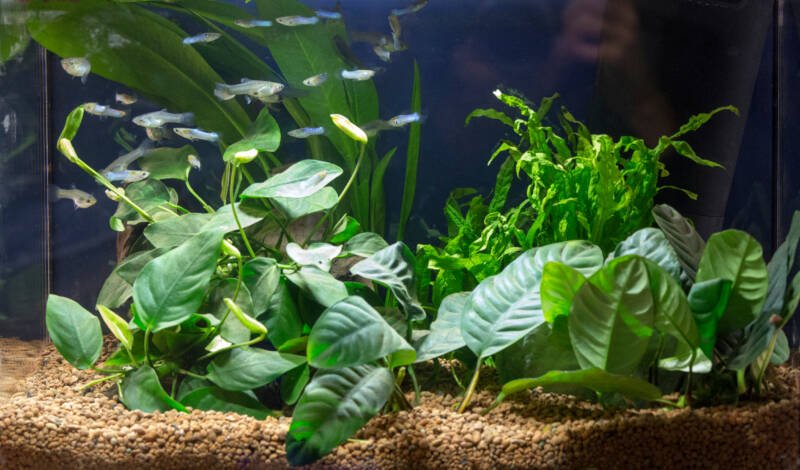
Guppies have an amazing tolerance for varying water conditions.
They can survive in temperatures as low as 65°F (18°C) and as high as 90°F (32°C)!
However, it is not recommended to push the edges of this range for reasons we will discuss below.
These fish do best in an optimal temperature range of 72 to 82°F (22 to 28°C).
This range is still sizable, which is appealing as it makes it easy to pair guppies with numerous other tank mates.
The Importance of Water Temperature
For your guppies to be their healthiest, you need to pay attention to their water quality, particularly the water temperature.
What Happens if Guppies are Kept in Cold Water?
Long-term exposure to low water temperatures will increase your guppies’ stress levels, leaving them vulnerable to infection and disease.
Low temperatures can also impact your guppies’ growth rate. You may find that your guppies have difficulties reproducing in cooler waters.
If you notice that your guppies are significantly less active, water temperature should be the first thing you check.
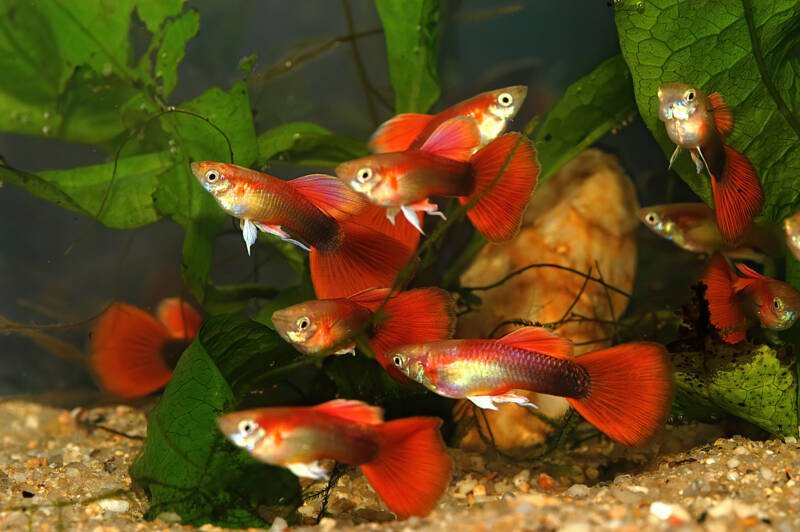
For a temperature that is too low, gradually raise it using a reliable water heater until it falls within the 72 to 82°F (22 to 28°C) range.
The minimum water temperature that your guppy can survive is 65°F (18°C).
Never let the water temperature drop below 60°F (15.5°C), or your guppies will die.
What About Hot Water?
As we mentioned, the maximum temperature that guppies can survive is 90°F (32°C); however, when the water temperature rises above 85°F (29°C), your guppies will begin to be negatively impacted.
As the water temperature increases, the amount of dissolved oxygen in the water decreases.
These reduced oxygen levels will cause your fish to have difficulty breathing.
Chronically high water temperatures will shorten your guppies’ lifespan.
As your guppy already has a short lifespan of two to five years, you do not want to do anything that will lower their odds of living a longer life.
In addition, high water temperatures can reduce the chances that your guppies will successfully breed. We will go into this more below.
Higher temperatures can also impact the beneficial bacteria in the tank, causing a reduced ability to convert ammonia to nitrites and nitrates.
The resulting ammonia spike can seriously harm your fish, including burning their gills.
Guppy Behavior in Different Water Temperatures
In addition to impacting their health and wellbeing, water temperatures can also impact guppy behavior.
One study done by Weetman, Atkinson, and Chubb indicated that female guppies showed an increased preference for larger shoals in the presence of a predator threat when the water temperatures were higher versus when they were lower.
While the scenario in the study is not likely in your home aquarium, the core takeaway is that guppies display different behaviors based on water temperature.
This is a great argument for keeping things stable as behaviors change in response to a threat or shift in stress levels, which water temperature changes can prompt.
Do Guppies Need a Heater?
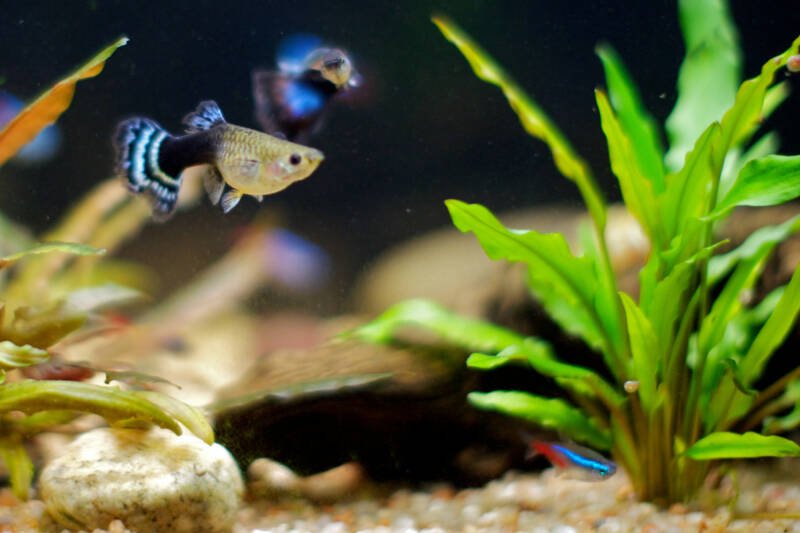
The short answer is yes. Many aquarists choose to keep guppies in smaller tanks of around 10 gallons (40 l), which are prone to rapid shifts in water parameters, particularly temperature.
Fluctuating water conditions will increase your guppies’ stress levels. Chronic stress will leave your guppies vulnerable to disease and may shorten their lifespan.
One way to minimize temperature shifts is to keep your tank in an area away from sunny windows or heating/cooling vents.
Some aquarists have had success keeping their tank in warmer parts of the house.
However, to truly ensure that the water conditions are stable, especially in areas where the ambient temperature can drop, it is best to install a heater and a thermometer.
Best Heater Types for Guppies
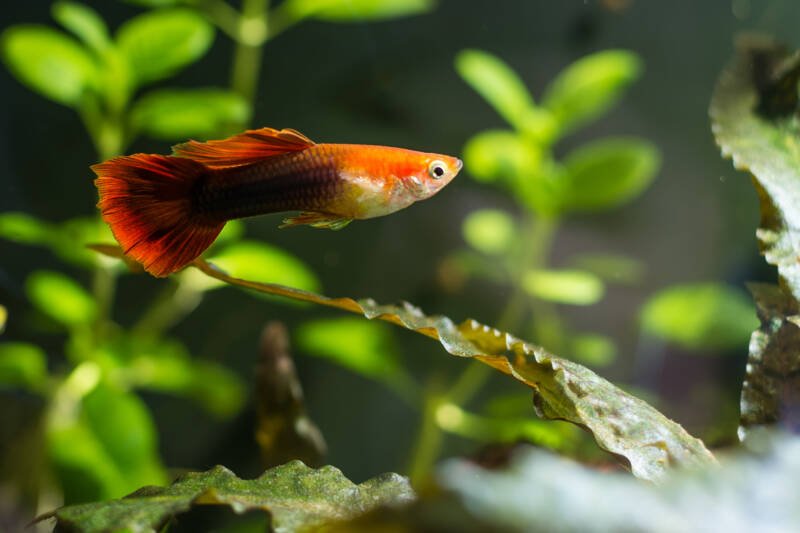
The ideal type of heater is one that is sized to match your tank.
When selecting a heater, think five watts per gallon of water in your tank.
This means for the minimum tank size of 10 gallons, you would need a 50-watt heater.
This is a small heater, so be sure to adjust the wattage calculation for larger tanks.
With guppies, you can choose whichever type of heater works best for your setup.
Hang on heaters, substrate heaters, filter heaters, or submersible heaters all work well.
The type you select is a matter of preference and fit for your aquarium.
Hang on Heaters
They are typically the least expensive and easiest to find.
The Submersible Heaters
This type of heater needs to be fully protected from the water, so they tend to cost a bit more.
Substrate Heaters
They have the benefit of being hidden, thus creating a pleasing aesthetic, and they distribute heat evenly throughout the tank.
Filter Heaters
Filter heaters are more powerful and suitable for larger tanks. These filters heat the water as it passes through the unit.
Warming or Cooling Your Guppy’s Water
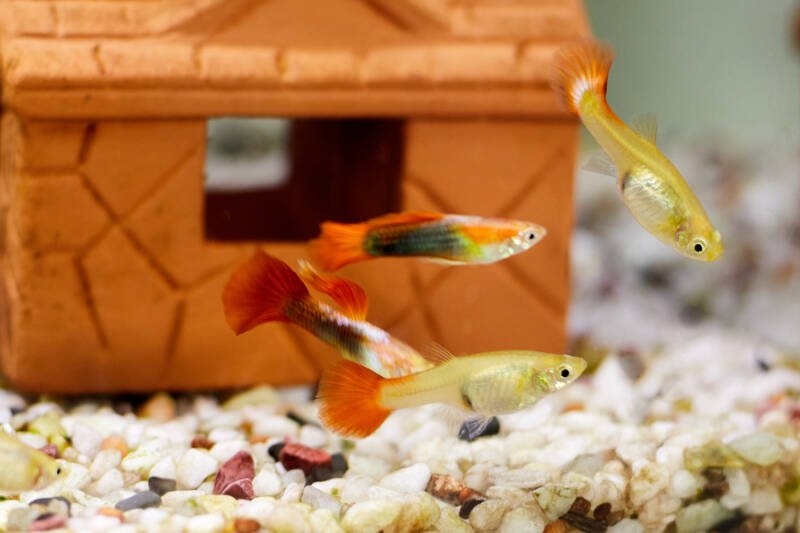
Even with the proper heater and thermometer, there may be times when you find your guppy’s water to be too cool or too warm.
In these cases, you will want to adjust the water temperature slowly so as not to shock your fish.
A safe rate of water temperature change is around two degrees Fahrenheit over an eight-to-10-hour period.
To warm the water, you can gradually increase the temperature that the heater is set to until the ideal water temperature is achieved.
To cool the water, you can remove the tank lid, turn off lights, and blow air over the water surface.
Keep an eye on the water temperature as you are making these changes to ensure there is not a rapid shift.
Take Care During Water Changes
Keeping the water temperature consistent during water changes is important.
Again, you do not want to shock your fish by suddenly dumping cold water into their tank.
Each week, you should change around 30 percent of the tank water.
In addition to making sure the chemical balance of the new water matches that in your tank, the temperature should match as well.
Use a thermometer to ensure that the temperature of the fresh water you are adding to the tank matches the water already there.
Ideal Guppy Breeding Temperatures
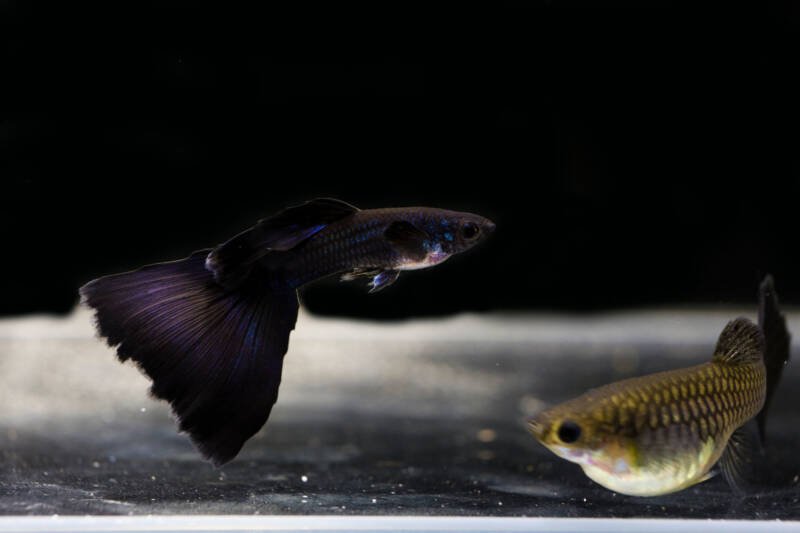
Guppies need warmer temperatures in order to successfully breed.
Keep the water between 72 to 82°F (22 to 28°C) as lower temperatures will slow down the activity of your guppies, including their breeding process.
If you have a pregnant guppy and wish to have a successful spawn, you will need to monitor the water temperature regularly.
A study done by İsmihan Karayücel, Orhan Ak, and Sedat Karayücel indicated that high water temperatures can adversely affect the survival rate of gravid female guppies.
Ideal Temperature for Guppy Fry
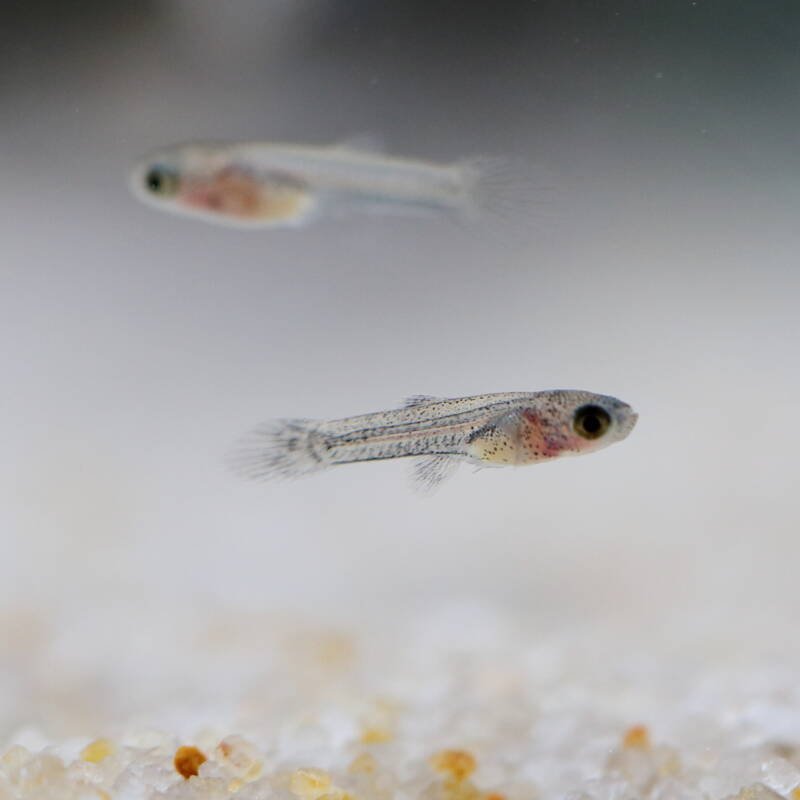
Similarly, guppy fry need care when it comes to water temperatures.
They will thrive and grow best in the 72 to 82°F (22 to 28°C) temperature range.
The same study by Karayücel et al. indicated that high temperatures outside of the optimal temperature range caused decreasing survival rates for guppy fry.
In addition, although not definitively proven by the study, the sex ratios of surviving fry may also be impacted by both low and high water temperatures.
In any case, for the best chance of success with this live-bearing species, keep the water temperatures well within the guppy’s ideal temperature range.
Things to Remember
Your guppies need your help to live their best life.
Paying attention to the water quality in your guppies’ tank, particularly water temperature, will go a long way toward keeping them healthy.
Remember to keep the temperature stable using an appropriately sized heater and monitor it with an installed thermometer.
Place your guppies’ tank away from windows or ventilation systems.
When performing water changes, ensure the temperature of the incoming water matches the water already in the tank.
We would love to hear from you!
What is your favorite heater setup to keep your guppies warm?